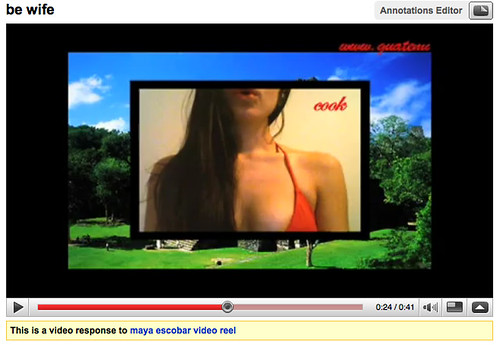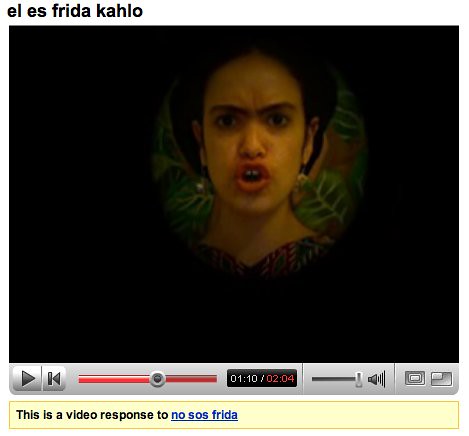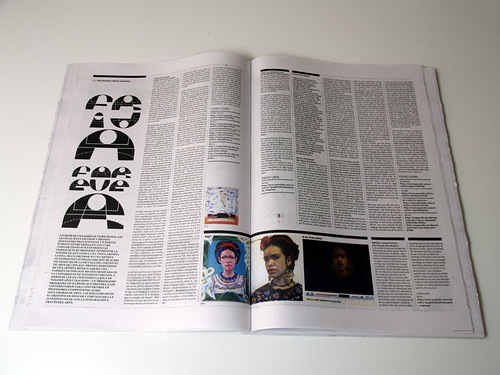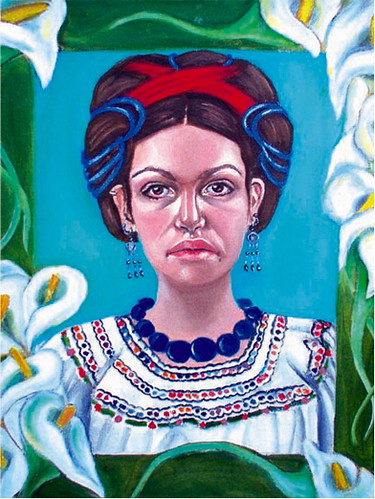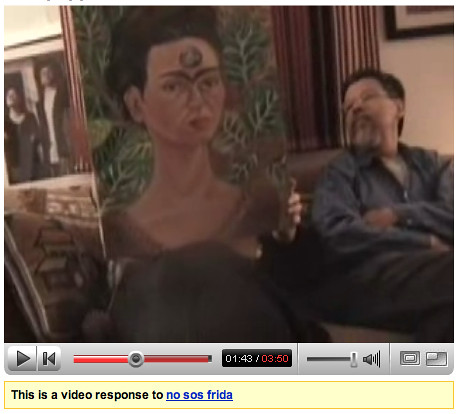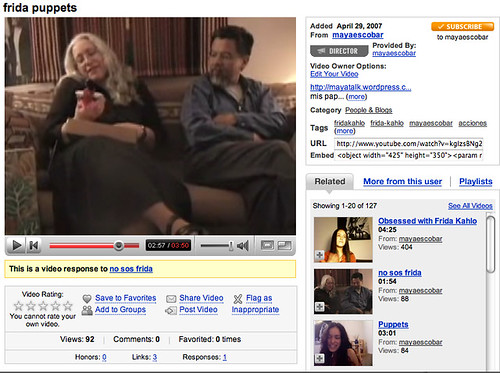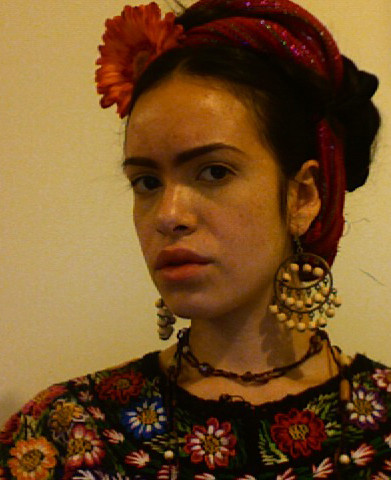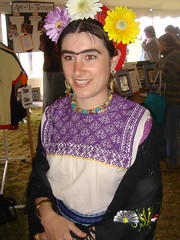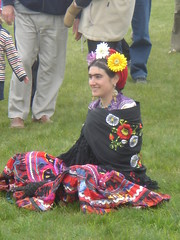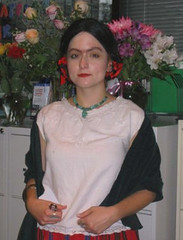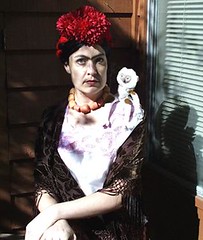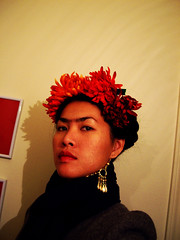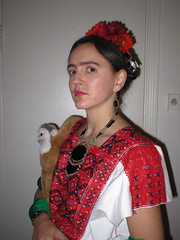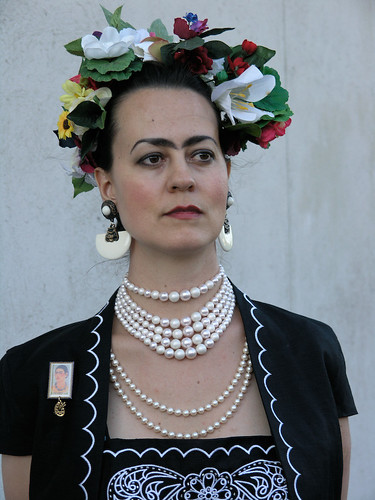Recently Latina Role Model was featured on TikiTiki Blog: stories with cultura, color and sabor, in a post by Carrie Ferguson Weir called Smart Latina vs. Sexy Latina. Carrie asked readers:
So, has your Smart Latina run up against the Sexy Latina? What do you see when you watch Maya’s video? What does it bring up for you? Why can’t we be both Smart and Sexy? Let’s talk about this, break it down, maybe shatter some stereotypes, and bust our own too.
Check out the PROFOUND difference in the nature of the comments left on this post (comments posted below) vs the ones left on YouTube.[youtube=http://www.youtube.com/watch?v=F_1X1igrL4U]my contribution to post on Tiki Tiki:
I perform over-the-top representations of different identities. I group together these representations (characters) as a means of challenging limited perspectives of what women are like, and in this case, what Latina women are like.
This character is supposed to be an intellectual, accomplished, socially conscious woman- who will forever be seen as the “Sexy Latina.” The low quality video blog is meant to mock scenes in movies, where the hot high school teacher walks down the hall and all the boys undress her in their minds.
But I am not taking a negative or positive stance either. I want to question the role Latinas play in perpetuating this persona, and question if that is even a bad thing? Are we limiting ourselves by continuing to have this same conversation, even though the behavior persists, are we enforcing it by bring more attention to it?
I haven't always been so impartial. Out of all of the characters in Acciones Plásticas, The Latina Role Model is the one I identified with the most. My original description of the way this character was perceived by others was much more reactionary and much angrier than it is now. (see below)
The Sexy Latina© from Acciones Plásticas free (stereotype) postcard, 2007
The Sexy Latina© is an educated woman who cares about important social and political issues. She wears suggestive provocative clothing to compensate for giving up her role as a homemaker. She uses her sexuality to obtain positions in the work world.
 Latina Role Model from Acciones Plásticas プリクラ 2009
Latina Role Model from Acciones Plásticas プリクラ 2009
Over the last two years this character has really evolved. Here is the new description of The Latina Role Model, re-imagined as part of my Acciones Plásticas プリクラ collaboration with artist Rio Yañez:
The Latina Role Model is a diploma totin’ intellectual, sexy, social media goddess.
What do you think? How does the earlier description of The Sexy Latina© differ from this new description of The Latina Role Model? How do these two images relate to the Latina Role Model YouTube video?
-
Sra. López says:
This is an excellent post and an excellent video. It really does make you think.I am really not qualified to speak from a “Latina perspective” on this topic because I am Anglo. (If you read my blog, you’ll know I’m Sra. López only because I married a Salvadoran.)That being the case, I can’t speak from personal experience on Latina stereotypes, but I would like to contribute an opinion or two on topics that are pretty closely related.For example, it really bothers me that the Latinas picked as reporters and journalists on Univision and Telemundo seem to be more for the purposes of eye candy than to report the news and add intelligent commentary — not that they aren’t intelligent women, but I think the sexism by the head honchos over there is pretty evident, not just on the news, but on other programming as well… And English language channels aren’t always much better. I think Western women in general – no matter what their race, fight very hard to overcome the sense that we are valued more as objects of sex/beauty, than for what’s inside.It’s very frustrating and I don’t envy the difficult job many women have of raising daughters in this world. (I have 2 sons) … With my own self esteem issues, I can’t imagine what a challenge it would be to raise a girl who is confident in herself and who doesn’t let Hollywood, fashion magazines, men, or even other females, get her down.I don’t know the solution to achieving true equality, but I think talking about it all is a good start.
-
Angelica Perez says:
Very interesting…The role model I immediately identified with was the socially-conscious, smart role model, which made me realize how loaded that role is. Being an accomplished and educated Latina comes with so many expectations — the whole giving back to the community, serving your community, being a role model and mentor for others, etc. — that’s not something that an accomplished non-Latina woman has to worry about (or feel committed to).With regards to the sexy role model — I always say that there is no sexier woman than the one that exudes confidence in herself and who she is — the sexy clothes are just extras…Great conversation…
-
[...] Tiki Tiki: Stories with Cultura, Color and Sabor, thanks to post by Carrie Ferguson Weir entitled Smart Latina vs Sexy Latina. Check out the post and be sure to leave your [...]
-
Ana Lilian says:
I guess I just never even thought of myself as the Sexy Latina…but a cute one yes! LOL! But once I´m on the dance floor, then the sexy comes out and it´s all good.But,seriously, I guess I just lack the perceived-Latina sassy-ness as I´ve never felt that bias towards me.I will definitely agree with dear Sra. López that the media, especially the Hispanic media, is completely promoting the hot Latina stereotype, and not much of the smart Latina one. Why do their “news” anchors feel they need to have their breast augmented to be taken seriously?
-
Kikita says:
I think it is inherent in our culture to be “hot” in every sense of the word because we are so passionate.I love what Maya was trying to accomplish and say with her video, but I found that she couldn’t hide or deny her Latin sensuality even when she was trying to play the part of an “intellectual, accomplished, socially conscious woman.”This DID make me stop and think, but what I realized is that I tend to shoot for a 3rd type. I go for “Classy Latina.” You know, the one that can wear the big hoops and sexy top with a pant suit. Someone like Ingrid Hoffman or Karla Martinez.
-
C. Morales says:
My impression is that Latina women play into the stereotype because Latino men often expect them to, and they are threatened by a smart woman. It is not just non-Latino men who expect a mujer caliente and nothing more.
-
Liz says:
How you project yourself, depends on you, no matter what. I, like Ana, never felt that I was looked at differently because I am Latina. I don’t see my self as a Sexy, Hot, Latina(I hope my husband does, though). Hell, I’m 33, been married for 12 years, and have 3 kids. I don’t get “chifles” anymore… ): LOL!This is directed towards the younger, single generation. How they present themselves as the future “Latina Generation”, depends on how they are raised. It’s up to us, as moms, to teach our daughters to go and be the BEST they can be. It’s up to me to raise my daughter to know what it right from wrong. Do guys really still think that girls are still destined to be “home/baby makers? Really??Forget Hollywood. Forget the Media. Heck, forget the evening news. If those ladies felt that they need to have their lady lumps hanging out in order to get the job, then I feel sorry for them. But, it is what it is.I will raise my daughter to know that education is the key to being classy and sexy! Not exposed Humps and Lady Lumps! Also, I will raise my boys to see women and they see themselves. Whether they marry a Latina or not.Ay, me pase de mas! he he!
-
SUZ says:
A smart and fun video commentary on the stereotypes of women in general…the educated intellectual, the hot babe, the innocent women. I like that Maya uses humor to deflect the extremes. Also that she creates a fine line between integrating the different role types. This is interesting because everyone is never just one thing…but we may choose to identify one way.
-
Melissa Garcia Logan says:
I think it’s part of a male dominated culture. Many women have this problem of having to manage male expectations in their professional lives, whether it is living with objectification or men projecting their need for nurturing from any woman they meet. I’ve had jobs where men thought it was okay to flirt with me and expected me to fulfill some messed up hot secretary fantasy, and I’ve had jobs where men I worked with expected me to be maternal and when I was driven, I was labeled aggressive. I’m not a dog, I’m not a hooker, and I’m definitely not your mother, guys.I think we have to teach men when they’re children that women can fill many roles and to expect them to be as capable and androgynous as any man performing the same duties. By the same token, I don’t know how I feel about using gender or sexuality as an asset to get ahead, my feeling is that anything you do that is manipulative in nature, is skirting unethical, if not flat out crossing the line.Having a sense of humor about stereotypes though, I don’t know if I see a problem as long as you don’t go too far and reinforce them. If it’s clear it’s a joke and part of the joke is how ridiculous stereotypical behavior really is…
-
 Carrie says:
Carrie says:I love the feedback, ladies. All great points and fabulous reflection.I am left wondering this, after reading Ana and Liz’s comments: Is stereotype/perception felt/seen at a greater level when we don’t live in predominately Latino communities?This comes to mind because your comments made me realize I never thought too much of my Latina side and my American side until I lived in cities where there weren’t a bunch of Cubans running around me everywhere. My otherness was apparent and pointed out. It was almost like, wow, I am different?Interesting!
-
Marta says:
I don’t fit into the Sexy or Brainy Latina mold at all. Probably because I look very Anglo – light skin, blue eyes. I blend pretty seamlessly into my So Cal suburban life.Except for the Latina “chispa.” That’s always the big giveaway right there. =D
-
Liz says:
Carrie,I emailed your post to my niece, whose studying at Penn State, this is what she had to say:Well, I agree with her lol. A lot of people especially here in Pennsylvania, see me as exotic because I’m Hispanic. They expect me to speak Spanish all of the time and a lot of them expect me to be kinda stupid and slutty. But when people get to know me, they find out that I’m extremely smart. Smarter than most people they encounter. And it sucks because I’m always having to prove myself to people and to teachers. But in the end, I’m the one that’s dropping jaws for my intellect and not for my attractiveness =)The end haha. Hope that helps.I am one PROUD Tia!!! (:
-
 Carrie says:
Carrie says:Liz, aha! Thank you for sending the post to your niece and validating my theory. I love how your niece wrote to you and the “stupid and slutty” line made me bust out laughing — especially because she obviously is not.Gracias, proud Tia!(Maybe she needs to write for the Tiki Tiki? hmmmm?)
-
Veronica says:
Great video and excellent points.I think that this expectation for Latinas to appear sexy is one reason why I reject the hot mom movement. I wish there was just as much social pressure to be smart Latinas, smart moms, smart women as there is to be hot, sexy, etc.
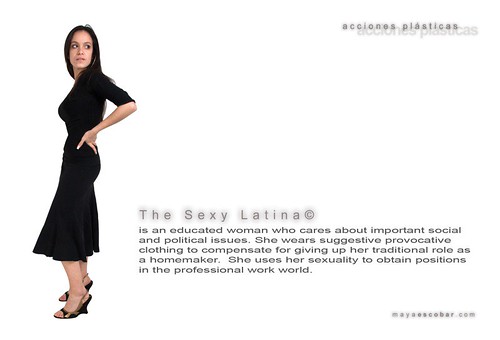

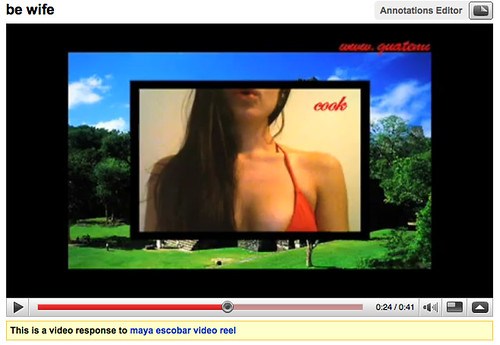
 I thought about this phenomenon in relationship to, the images that my friends and I had posted on Myspace throughout that year. I unknowingly went from being slightly annoyed and simultaneously amused by the phrase "take a picture of me for my Myspace", to it becoming completely natural and almost organic to document every moment, every outing, every time my friends and I put on make up, and to take pictures for Myspace. I saw this behavior even further exaggerated in the high school students I was student teaching. Their conversations were dominated with events that had transpired on Myspace, and when they were not talking about Myspace they were taking pictures for Myspace.When we talked about the factors that contributed to the construction of their individual and collective identities, my students were quick to bring up their style of dress, group of friends, the neighborhood they lived in, and the way they spoke. Yet not a single student referenced their online activity, the pictures they posted, the groups they joined, the comments they left on each others pages. I wondered why it was, that they were so aware of and adept at reflecting upon their experiences in the material offline world, but failed to mention the social network that played such a major role in their day-to-day lives.
I thought about this phenomenon in relationship to, the images that my friends and I had posted on Myspace throughout that year. I unknowingly went from being slightly annoyed and simultaneously amused by the phrase "take a picture of me for my Myspace", to it becoming completely natural and almost organic to document every moment, every outing, every time my friends and I put on make up, and to take pictures for Myspace. I saw this behavior even further exaggerated in the high school students I was student teaching. Their conversations were dominated with events that had transpired on Myspace, and when they were not talking about Myspace they were taking pictures for Myspace.When we talked about the factors that contributed to the construction of their individual and collective identities, my students were quick to bring up their style of dress, group of friends, the neighborhood they lived in, and the way they spoke. Yet not a single student referenced their online activity, the pictures they posted, the groups they joined, the comments they left on each others pages. I wondered why it was, that they were so aware of and adept at reflecting upon their experiences in the material offline world, but failed to mention the social network that played such a major role in their day-to-day lives.
